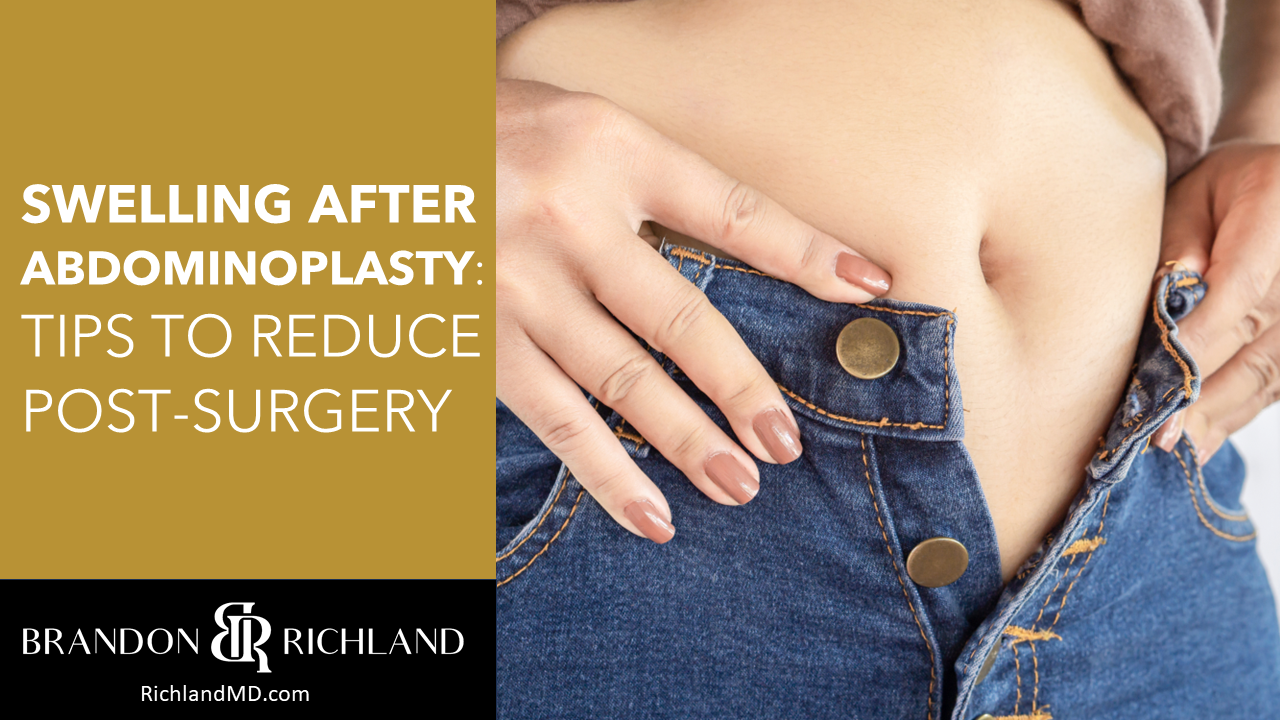Published by Dr. Brandon Richland, MD

Surgical procedures such as tummy tuck can cause swelling as the body repairs from the trauma triggered by a surgery. The body removes fluid in the area a lot slower, resulting in fluid buildup known as edema or swelling.
Key Takeaways of Swelling After Abdominoplasty
- Swelling after abdominoplasty is a normal response to the surgery, as inflammation occurs when tissue is damaged and the body goes through its natural healing process.
- Knowing the typical duration of the postoperative swelling is important for tracking progress and understanding expectations.
- Recovery after an abdominoplasty consists of wearing a compression garment, elevating the legs, using cold compresses, following a regular hydration and nutrition regime, as well as avoiding strenuous activities.
- It is important to be aware of the potential complications and risks related to swelling after abdominoplasty, including seroma formation, infection, delayed wound healing and poor aesthetic results.
Why Does Swelling Occur After Abdominoplasty?
Swelling is a common side effect of abdominoplasty or tummy tuck surgery and can be caused by fluid accumulation, disruption of the lymphatic system, inflammation response, and tissue trauma.
During an abdominoplasty procedure, the surgeon makes incisions in order to reposition the abdominal muscles and remove excess fat and skin. This disrupts blood vessels, which leads to slowing of drainage that results in accumulation of fluid.

Lymphatic System Disruption
This can occur after abdominoplasty and is a primary cause of swelling and edema in the abdomen. Because tissue trauma occurs during an abdominal procedure, capillary permeability can increase, leading to fluid accumulation around the muscle walls within the surgical field.
This is compounded by disruption of the lymphatic system responsible for draining excess fluids away from other organs. Without proper function, tissues may become engorged with blocked drainage resulting in increased inflammation and pain.
Tissue Trauma
Tissue trauma is a common cause of swelling after abdominoplasty. During a traditional tummy tuck, excess skin and fat are removed from the abdominal area to increase the aesthetic appearance of the body profile.
The Normal Duration of Swelling
Initial Swelling
The initial swelling after a tummy tuck is caused by fluid accumulation due to the surgery, lymphatic system disruption, inflammation response, and trauma to the tissue. This type of swelling can last up to four weeks.
The swelling is due to a combination of factors such as increased blood flow around the area plus decreased lymphatic drainage that has been disrupted by the surgical procedure.
It’s important for patients who have undergone an abdominoplasty or tummy tuck procedure to manage their initial swelling by implementing appropriate lifestyle changes such as avoiding strenuous activity, elevating their legs when possible, and wearing compression garments throughout the healing period.
Peak Swelling
The majority of swelling after abdominoplasty, typically the most noticeable, occurs around day 3 to 5 post-op. This period of peak swelling can often last for several weeks, and it can be soft to the touch.
It reaches peak levels within 3 days to 14 days but can vary from person to person depending on how well they care for themselves in terms of rest and nutrition during post operative recovery.
Subsiding Swelling
As the body recovers from abdominoplasty surgery, swelling typically begins to subside. Around 80% of the swelling should dissipate within two months post surgery.
It is important to remember that everyone’s recovery timeline is unique and may take longer depending on various factors such as age, skin type, tissue trauma during the operation and how well a person follows their aftercare instructions.
Managing Swelling After Abdominoplasty
Recovery after an abdominoplasty consists of wearing a compression garment, elevating the legs, using cold compresses, following a regular hydration and nutrition regime, as well as avoiding strenuous activities.

Wearing Compression Garments
Immediately after a abdominoplasty procedure, an important aspect of post operative care to reduce swelling and bruising near the incision site is to wear compression garments. These medically grade garments help improve the body’s overall appearance by reducing sagging skin due to extra fluid accumulation, while also promoting optimal healing.
Elevating the Legs
Elevating the legs is a common advice given by doctors to reduce swelling after an abdominoplasty. Lying down with your feet raised can be effective for reducing fluid accumulation in the upper thighs and lower legs, which may otherwise cause persistent or prolonged swelling.
Cold Compresses
Cold compresses are an effective and popular treatment for swelling after abdominoplasty. Cold temperature is frequently used to reduce tummy tuck swelling, post operative pain, and bruising due to its ability to reduce inflammation and constrict the blood vessels in the affected area.
Taking Prescribed Medications
After abdominoplasty surgery, the patient will be prescribed antibiotics to help minimize infection risk. A doctor might suggest anti-inflammatory medications like ibuprofen or naproxen to reduce inflammation and swelling throughout the abdominal area.
Non steroidal drugs may also be used in some cases to optimize comfort levels for the patient during post operative recovery. Oral supplementation including vitamin E, selenium, and zinc are known to improve recovery times and reduce bruising after tummy tuck procedures, helping optimize recoveries from surgery with minimal ecchymosis and edema.
Finally, doctors often prescribe pain medication such as hydrocodone or acetaminophen or commonly known as Vicodin for intraoperative pain control, which can have an added benefit of reducing generalized post operative swelling if taken properly under medical instructions.
Using Lymphatic Drainage Techniques
Lymphatic drainage is a therapeutic massage technique used to help reduce swelling and speed up the healing process after surgery. It helps improve the body’s lymph circulation, allowing it to eliminate excess anesthesia, reduce swelling, and flush out byproducts generated during the procedure.
This improves skin quality and reduces inflammation around your incision site due to the mild pressure applied with sweeping hand movements that help direct fluids toward specially emptied nodes in the body.
Studies have shown that tummy tuck patients who received regular postural exercises experienced shorter healing times, reduced swelling, improved skin texture and density significantly more than those who only followed conventional advice.
Frequently Asked Questions About Swelling After Abdominoplasty
1. What is Abdominoplasty?
Abdominoplasty, also called a tummy tuck, is a type of surgery used to remove excess skin or fat from the lower abdomen area to tighten up the stomach region.
2. Will I Experience Swelling After Abdominoplasty?
Yes, some degree of swelling in the abdominal area is common after abdominoplasty as your body adjusts to the changes. It usually begins 5 to 7 days after surgery and peaks at 2 weeks before gradually resolving over time.
3. How Can I Reduce Swelling Following an Abdominoplasty?
To reduce post operative tummy tuck swelling, you should use ice packs when needed for pain relief. You can have them 3 times a day for 20 minutes each session during most of the first week following surgery.
You should also keep moving by doing gentle stretching exercises that are approved by your doctor, while avoiding lifting heavy objects or intensive physical activity during the tummy tuck recovery period.

Conclusion and Summary of Swelling After Abdominoplasty: Tips to Reduce Post-Surgery
Abdominoplasty is an effective body contouring procedure that helps improve the shape and definition of the abdominal area. Swelling after this procedure can be uncomfortable and frustrating for many patients.
It is important to understand that the normal timeline of post-op activities and healing process includes a period of anticipated swelling. Though this may vary between people, most individuals experience peak swelling within 72 hours post surgery, followed by initial subsiding during 1 to 2 weeks, while 80% of the total volume should subside in about two months.
To reduce discomfort due to swelling after abdominoplasty, various strategies can be employed such as wearing compression garments, elevating legs or applying cold compresses, following all instructions given by your surgeon, and seeking professional medical help if excessive pain or prolonged swelling persists beyond the expected time frame. This will ensure not only a successful recovery but also satisfaction with aesthetic results following abdominoplasty.
Please note that this article is intended for informational purposes only and should not be construed as medical advice. Before making any changes to your treatments, please consult with your healthcare provider to discuss the appropriateness and safety of such changes.
Ready For Your First-Class Cosmetic Experience in Orange County (OC) California (CA)?
Are you located in one of these Orange County (OC) / Southern California cities?
Aliso Viejo, Anaheim, Brea, Buena Park, Costa Mesa, Coto de Caza, Cypress, Dana Point, Fountain Valley, Fullerton, Garden Grove, Huntington Beach, Irvine, La Habra, La Palma, Laguna Beach, Laguna Hills, Laguna Niguel, Laguna Woods, Ladera Ranch, Lake Forest, Los Alamitos, Mission Viejo, Newport Beach, Orange, Placentia, Rancho Santa Margarita, San Clemente, San Juan Capistrano, Santa Ana, Seal Beach, Stanton, Tustin, Villa Park, Westminster, or Yorba Linda?
Plastic Surgeon Dr. Brandon Richland, MD and our Cosmetic Aesthetics Team are ready to help you look and feel your absolute best.
Elevate your confidence and self esteem levels to unfathomable new heights!
Schedule your in-person consultation in our modern and luxurious offices in either Fountain Valley, CA (Main HQ) or our Newport Beach, CA office.
Do you live outside of Southern California or short on time? For your convenience, Virtual Consultations are also available.
Our warm and engaging Team of carefully selected Aesthetics Professionals will make you feel calm, cool, collected, and right at home throughout your entire consultation and surgery process.
Schedule Your Aesthetics Consultation here, or call us directly at 949-867-4496 today.
About the Author

Dr. Brandon Richland, MD is a respected Board Certified Licensed Plastic Surgeon in Orange County / Southern California specializing in cosmetic and reconstructive surgeries.
Driven by his passion for medicine, Dr. Richland obtained his Doctor of Medicine (M.D.) degree from the prestigious program at Saint Louis University (SLU) School of Medicine in 2013. His exceptional skills were recognized when he received the McGraw Hill / Lange Medical Student Academic Achievement Award, and graduated top of his class with Honors. For his undergraduate degree, he attended University of California, Los Angeles (UCLA) and graduated with Honors in 2009.
To further enhance his surgical expertise, Dr. Richland completed his Residency in Plastic Surgery at the University of California, Irvine (UCI) from 2013 to 2019 earning the Academic Achievement Award twice during this period. A total of 14 years in dedicated schooling and medical residency.
Dr. Richland is actively involved with healthcare and medical societies, as a Diplomate of the American Board of Plastic Surgery, a member of the American Society of Plastic Surgeons, American Society of Aesthetic Plastic Surgeons, and the California Society of Plastic Surgeons.
Contact Dr. Richland today by visiting RichlandMD.com, scheduling a cosmetic consultation, or by calling 949-867-4496 directly.
Cover Image Credit: Doucefleur / 123RF.com (Licensed). Photo Illustration by: Dr. Brandon Richland, MD.










